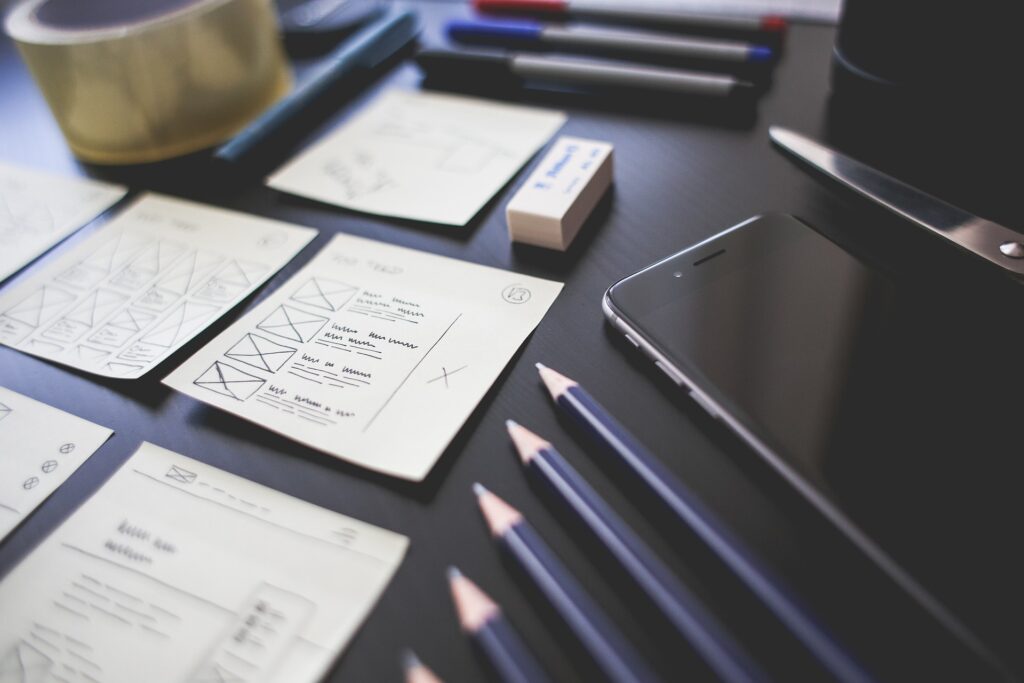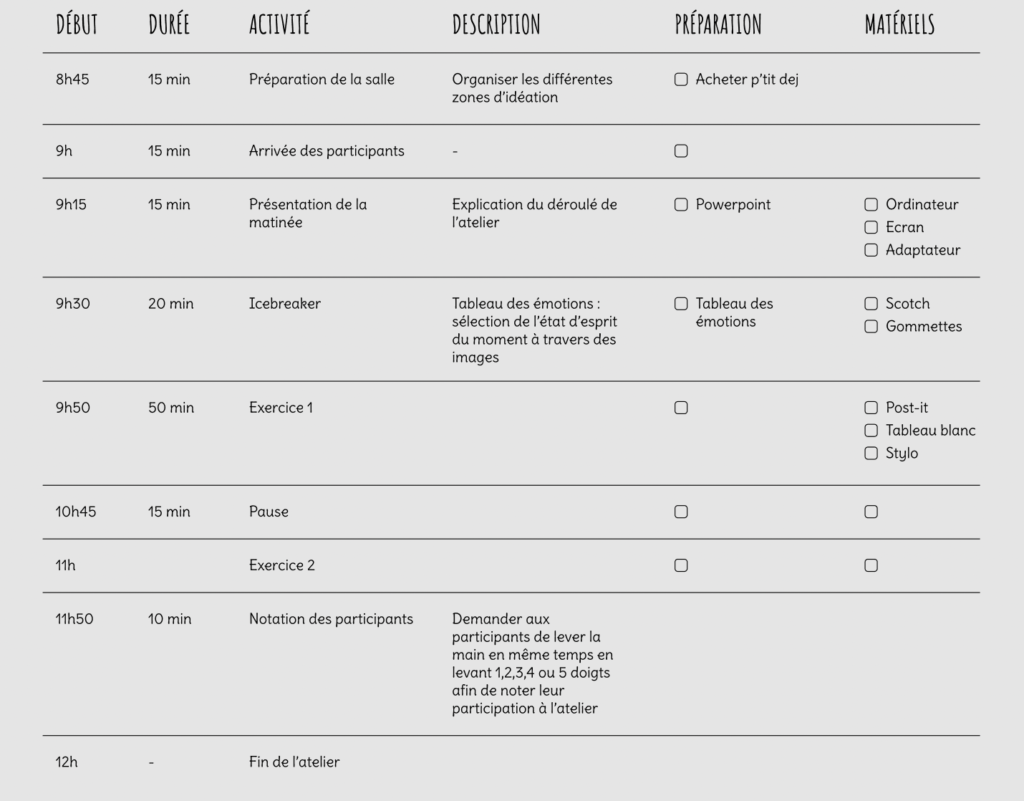When we hear the word “workshop”, we very often associate it with “good atmosphere”, “moment of exchange”, “moment of escape”. It reminds us of post-its, stickers, drawings, brainstorming, a whiteboard, games based on paper airplanes, in short, a fun activity that is not without importance. These workshops make it possible to highlight essential and essential elements to move forward effectively in the design of a solution.
However, many fears arise when deciding to organize a workshop: Will the participants be receptive? Will I succeed in captivating them during the 4 hours planned? Will all the people invited be present on the d-day? Am I going to keep my timing?
In this article, discover some tips that will allow you to approach your co-creation workshops more calmly.
All workshops require preparation
A workshop, from an external point of view, can seem very simple for the participants. However, its preparation is much more complex than it seems. Good preparation is not visible to a participant. On the other hand, if a workshop is not properly prepared, the collective energy will not be reached, or worse, the participants could not understand its interest and have the impression of wasting their time by participating in it.
#1 – Choose the right time of day
Choosing the time of day can have a huge impact on your workshop. Indeed, when you organize a 3h or 4h workshop, it is often as much time “lost” in the work of your participants. It is therefore important to choose a moment conducive to the attention of your participants:
● Prefer a workshop in the morning before your participants start their day, this will prevent Jean from thinking about the emergency received by email at 9:30 this morning or Julie dreaming of a digestive siesta after lunch at the restaurant.
● Avoid Monday and Friday, which are the days of resumption or preparation for the weekend. If you have the possibility to choose between the last three days, Tuesday is the ideal day.
#2 – Establish a detailed schedule
Whatever the nature of the workshop you organize, it must be effective and efficient. To do this, we strongly recommend that you draw up a detailed schedule for your day, listing the key elements for the success of your workshop.
To establish it, you must first define the principal objective of your “What should we achieve” workshop and know the number and profile of participants to adapt your exercises.
Once these cards are in hand, it's up to you to guide your workshop and lead it through your favorite exercises (card sorting, robot portrait, storymapping, brainstorming, etc.) towards your goal. Don't forget to set a time for each one!
Attention, in any workshop, there are certain steps that you must not forget to take into account for its smooth running:
● The Icebreaker at the beginning of the workshop to know the state of mind of the participants or immerse them in the atmosphere.
● A break every 1h30-2h to prevent your participants from dropping out during part of the workshop.
● The participants' feelings at the end of the workshop to help you improve and understand why one exercise worked better or less well than another.
#3 – Send and build your invitations
One of the main fears when you want to organize a workshop is the lack of participants. To encourage the participation of key players in your project, it is important to build and send an optimized invitation:
● Select the participants well. There is no point in putting the whole company in the invitation if in the end only the product service is concerned. Remember to vary the profiles so that your thinking takes into account all end users.
● Send your invitation well in advance of your workshop. Your workshop will probably not be clear in your head yet, but it is important that participants block your slot. You can therefore send your invitation with a first text reassuring them about the format and telling them that you will come back to them a few days before the workshop with a more detailed agenda.
● Send the workshop agenda a week before your workshop. If some answers change, you will have plenty of time to review the organization of your workshop.
A workshop is not supposed to ask your participants to work up and down, so reassure them. Tell them that they won't have anything to plan except come in a good mood. As soon as they receive the invitation, they will be reassured to see that it does not add to their current work.
Animate your workshop effectively
#1 – Create a reassuring atmosphere
Being in a workshop can be overwhelming for some people. As a facilitator, it is up to you to put your participants at ease as soon as they arrive:
● Plan something to eat and drink throughout the workshop: it's always nicer to have a warm welcome with a coffee and a chocolate.
● Prefer a layout of the room conducive to discussion: each participant must see each other, avoid layouts one behind the other and propose a layout in a circle.
● Reassure them about the format: it's a moment of exchange, there are never any wrong answers, on the contrary it is with all the opinions that we will move forward.
● Prepare the workshops before they happen: if you are planning a brainstorming workshop, prepare your whiteboard with a title and/or some ideas already pre-written. It's always impressive to start from a blank page.
● Establish a climate of trust with a round table and an Icebreaker exercise so that all participants feel involved in the exercises that will follow.
#2 – Propose benevolence rules
To have a climate of trust throughout the duration of the workshop, do not hesitate to recall at the beginning of the presentation some rules of benevolence and have them validated and adjusted with your participants.
Here are some sample rules:
● Use familiarity.
● Share your experience.
● Listen to each other, one conversation at a time.
● Leave the computer and the telephone closed.
#3 – Know how to adapt your schedule
The detailed planning you have made is a personal guideline for your workshop to achieve its goal. However, and this is the magic of a workshop, depending on the people present, the exercises can evolve and not happen as you had imagined at the start, which is often positive for the project. It's up to you to adopt more flexibility to finally make an exercise last longer or, on the contrary, to delete some if you identify that the participants are not receptive. Keep in mind the timing and the objective of your workshop and listen to the participants to adapt it and thus make it truly co-creative.
Inform participants of the impacts of the workshop
Giving importance to people's voice is one of the main roles for a UX Designer. Thanks to the participants of your workshops, you were able to propose optimal solutions, so let them know that they made it possible to achieve great things. By valuing their participation, they will be more attentive to future workshops, and will feel reassured.
This step allows participants to understand why they participated in your workshop, and you, to give credibility to your expertise and above all to find greater motivation from your participants for your future workshops.
Conclusion
The specificity of a workshop lies in its format which is spontaneous, instantaneous, collaborative and unique. The information collected is precious, it is up to you to structure it in such a way as to make it efficient and effective. Carrying out your workshop at strategic moments while coupling it with a detailed schedule, allows you not to forget anything on the d-day and facilitates the adaptation of the exercises if last minute changes appear.
If your project requires several workshops, remember to always keep the same participants in order to be able to explore the ideas brought up in workshop 1. Satisfaction is greater when the participant can discover the result in workshop 4 while having followed the evolution of a week to week.
Cécile BERNET – UX Designer @UX-Republic
Our next trainings
UX/UI ECO-DESIGN # Paris
SMILE Paris
163 quay of Doctor Dervaux 92600 Asnières-sur-Seine
DESIGN THINKING: CREATING INNOVATION # Belgium
UX-REPUBLIC Belgium
12 avenue de Broqueville - 1150 Woluwe-Saint-Pierre
MANAGING AND MEASURING UX # Paris
SMILE Paris
163 quay of Doctor Dervaux 92600 Asnières-sur-Seine
DESIGN SPRINT: INITIATION & FACILITATION # Paris
SMILE Paris
163 quay of Doctor Dervaux 92600 Asnières-sur-Seine
UX-DESIGN: THE FUNDAMENTALS # Belgium
UX-REPUBLIC Belgium
12 avenue de Broqueville - 1150 Woluwe-Saint-Pierre
GOOGLE ANALYTICS 4 #Paris
SMILE Paris
163 quay of Doctor Dervaux 92600 Asnières-sur-Seine
ACCESSIBLE UX/UI DESIGN # Belgium
UX-REPUBLIC Belgium
12 avenue de Broqueville - 1150 Woluwe-Saint-Pierre
EXPERIENCE MAPPING # Paris
SMILE Paris
163 quay of Doctor Dervaux 92600 Asnières-sur-Seine















